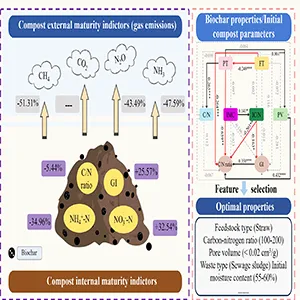
Biochar supercharges composting while cutting greenhouse gas emissions
Composting sounds like the perfect solution to waste. It turns leftovers into nutrient-rich soil. Yet, there’s a catch – it also produces harmful gases. Methane, ammonia, and nitrous oxide escape into the air and contribute to global warming.
A new study from Sichuan Agricultural University and international collaborators found a simple fix for that. The answer isn’t a machine or a new chemical – it’s biochar.
Biochar looks like black dust. It’s made by heating plant material such as straw in low oxygen. Farmers have used it for centuries to improve soil. This new research shows that it can make composting faster, cleaner, and better for the planet.
Faster, cleaner composting with biochar
The study analyzed 125 composting projects from different countries. The results were surprisingly consistent. Compost mixed with biochar matured faster and released fewer greenhouse gases.
“Biochar doesn’t just make compost richer; it also makes the process cleaner,” said lead author Jianmei Zou. “We found that the right kind of biochar can speed up decomposition, reduce harmful gases, and produce a more stable, mature product for farmers.”
Compost quality jumped. The germination index, a measure of compost safety, rose by about 25 percent. Nitrate nitrogen increased by 32 percent. At the same time, ammonium nitrogen dropped by 35 percent.
Even the carbon-to-nitrogen ratio – an indicator of how ready compost is – fell by 5 percent. Those changes mean faster decomposition, cleaner output, and less loss of nutrients.
Biochar slashes greenhouse emissions
Composting might seem harmless, but it’s a quiet polluter. The process naturally emits methane and nitrous oxide – two gases far stronger than carbon dioxide. Adding biochar changes that.
The study found methane dropped by 51 percent, nitrous oxide by 43 percent, and ammonia by almost half. That’s not a small difference – it’s a game changer for climate-conscious agriculture.
How does a simple carbon material do that? Its porous surface lets air circulate inside compost piles. That air suppresses methane-producing microbes and supports bacteria that use oxygen.
Biochar also traps nitrogen, keeping it from escaping as ammonia. In short, it holds on to what the soil needs and stops what the air doesn’t.
Ideal composting mix found
The team didn’t stop at general results. They wanted the ideal combination of materials and conditions. The winning formula came from straw biochar heated above 400°C (752°F).
The best samples had small pores, moderate surface area, and a carbon-to-nitrogen ratio between 100 and 200.
Compost piles worked best when 12 percent of that biochar was mixed in, along with sewage sludge at about 55–60 percent (moisture).
Under those settings, compost broke down smoothly. The mix stayed moist without turning soggy. Microbes worked efficiently, odor dropped, and nitrogen stayed in place.
The difference was visible not only in emissions but also in compost texture and maturity.

Microbes thrive with biochar’s help
Biochar doesn’t just sit in compost – it changes how it breathes. The tiny holes on its surface act like air vents and microhomes for bacteria. Those microbes thrive, breaking down waste faster and more evenly.
The small pores hold nutrients and oxygen, creating a steady environment that supports growth instead of decay.
The study found that smaller pores mattered most. Biochar with large openings or made from wood slowed the process. It trapped too much carbon and blocked airflow.
Straw-based biochar, in contrast, provided the right mix of structure and chemistry. It created compost that matured quickly and retained valuable nitrogen compounds.
What makes compost truly work
The researchers ranked which features had the greatest effect. Pore volume topped the list, followed by the type of biochar, the amount added, and moisture content.
“This ranking framework helps producers make smarter choices when designing composting systems,” said co-author Fei Shen. “It turns a complex biological process into something predictable and scalable.”
Adding more than 12 percent straw biochar gave the best results. Compost with balanced moisture – between 55 and 60 percent – performed better than both drier and wetter setups.
Starting with an initial carbon-to-nitrogen ratio of 24 to 28 also helped keep the process steady.
The findings now offer a clear, practical guide for farms and waste facilities aiming to reduce emissions without heavy technology.
From waste to resource
Biochar brings a double benefit. It cleans the composting process and makes use of agricultural leftovers.
Farmers can convert straw, crop waste, or plant residues into biochar, then use that biochar to create better compost. It’s recycling feeding recycling. This loop cuts emissions, reduces waste, and improves soil health all at once.
The study recommends tracking other compost indicators such as humic acids and dissolved organic carbon. These could show how biochar influences soil health in the long run. Cleaner compost today might mean stronger, more fertile soils tomorrow.
Ancient carbon, modern purpose
Long before modern labs existed, ancient farmers in the Amazon used charred organic matter to enrich their soil.
Centuries later, scientists have confirmed that idea works even better than they imagined. The new research proves that biochar isn’t just an agricultural additive – it’s a climate tool.
By improving compost quality and cutting greenhouse gases, biochar connects waste management and sustainability in one simple step. “Biochar doesn’t just make compost richer; it also makes the process cleaner,” added Jianmei Zou.
One material. One small change. Yet the impact could reshape how farms, cities, and homes handle waste – less gas, better soil, and a cleaner planet.
The study is published in the journal Biochar X.
—–
Like what you read? Subscribe to our newsletter for engaging articles, exclusive content, and the latest updates.
Check us out on EarthSnap, a free app brought to you by Eric Ralls and Earth.com.
—–













